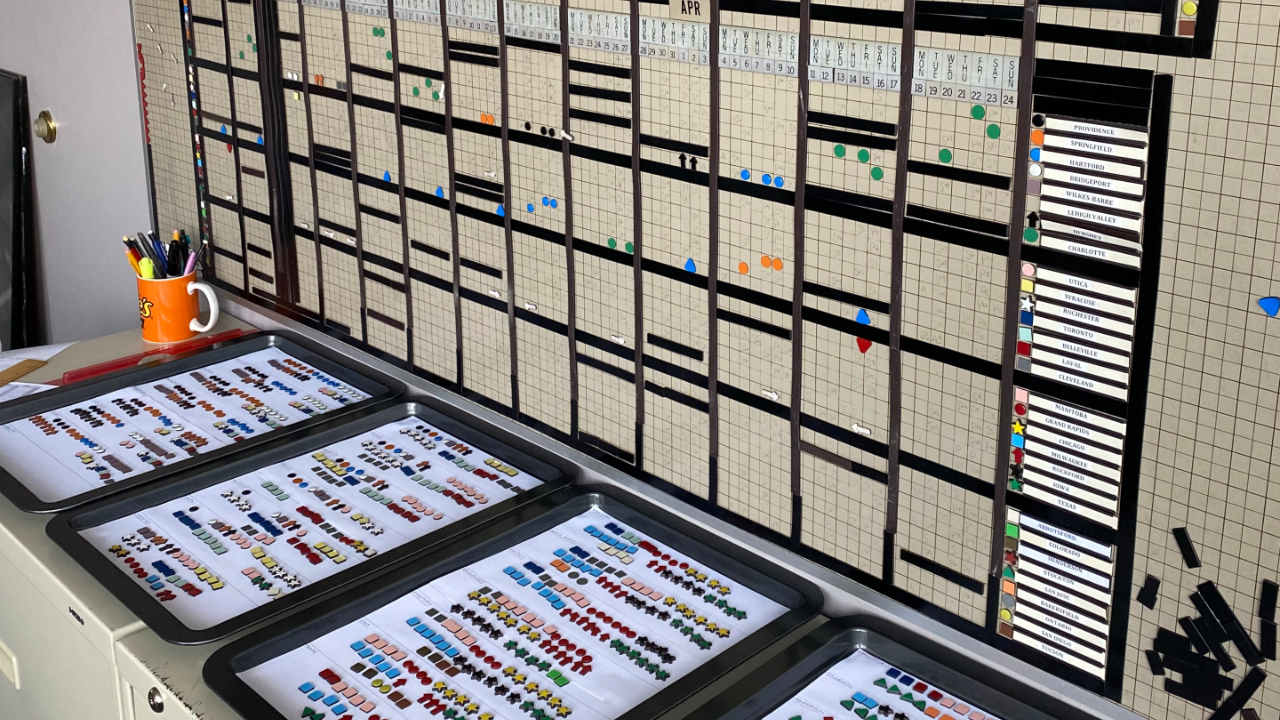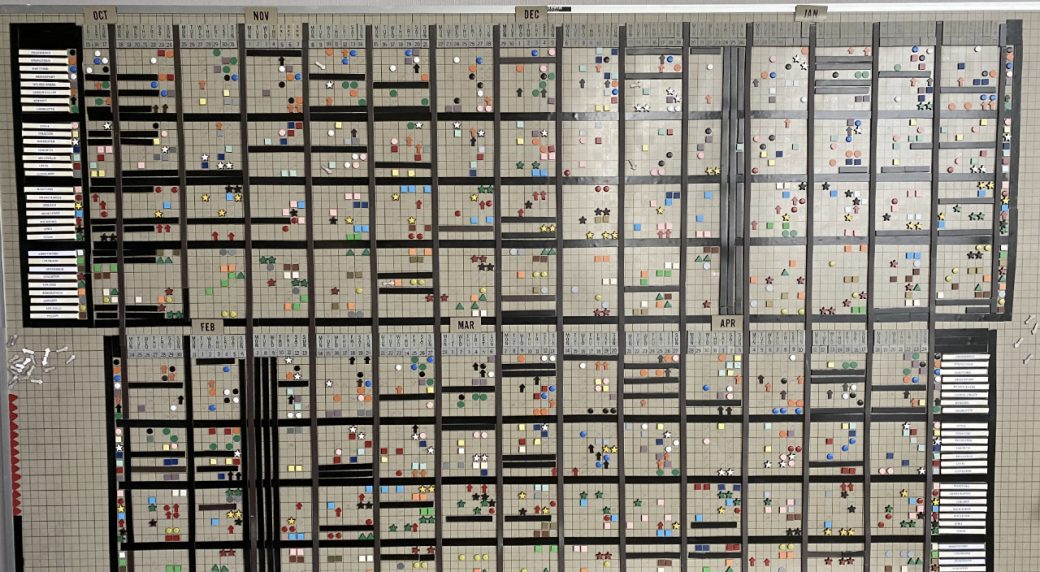In a normal year, without the pandemic throwing in monthly plot twists, stitching together the schedule for a 31-team league is already chaotic enough.
For the AHL, it’s a meticulous process — more than 1,000 games mapped out across two countries, in buildings where the league’s clubs are never the primary tenants. Then there’s the cap on how many games teams can play in a five-day stretch, limited by the league’s mandate to provide enough time for practice and development. Or there’s the fact that 75 per cent of those games need to be played between Friday and Sunday, another complication to factor in, along with travel time, player safety, and all the rest.
All told, getting the final schedule pinned down is about a seven-month process, says Melissa Caruso — the AHL’s vice president of hockey operations and governance, and the central architect of that monstrous schedule — meaning the process of finishing one season's schedule is followed unnervingly closely by preparing for the next.
“It's definitely a beast,” Caruso says. “A lot of people always ask me, you know, 'Don't you have a computer system that can do it for you?' There certainly are systems out there — we have not utilized them yet. I have a magnet board in my office that's about the size of the wall. Each of our teams is a certain colour and shape of magnet, and we basically build this thing like a puzzle.”
It starts in January, collecting and reviewing date submissions from each of the league’s 31 teams. Caruso guarantees a handful of them for each organization by March, so they can start up the process of selling and promoting an early collection of games. From there, it’s just about slowly, steadily, solving the puzzle.
The problem is, over the past two years, that puzzle’s gotten impossibly difficult. The pieces have changed shape, shifted position, the board at times falling out from underneath them.
In early 2020, Caruso — like the rest of the sports world — didn’t foresee the pandemic causing much disruption to that schedule. By March 12 of that year, the league suspended play. By May, the season was cancelled altogether, the focus turned to somehow plotting out what the following season might look like amid a storm of unknowns. Forget putting the puzzle together — Caruso’s team had to first figure out what it even looked like.
“That was probably about eight months of schedule modelling, talking about varied lengths of the season, differing start times, number of games, schedule format, all that stuff,” Caruso says.
It took the rest of the year, right up until a board meeting on New Year’s Eve, for the league to settle on a start date for 2020-21. The campaign wound up seeing three teams unable to participate due to the financial impact of the pandemic, the rest only playing within their divisions. The season finished without a Calder Cup champion crowned for the second straight year.
“Sometimes I think it was all a blur,” says Caruso. “I think the decision to play at all last season was a big one. You know, our board came together and decided, ‘Our purpose is to serve as a development league for the NHL. The NHL needs us this year. We're going to find a way to play.’ And that's what we did.”
Three seasons in, that blur of pandemic chaos has yet to fully come into focus.
Much like in the NHL, a smooth start has descended into waves of postponements, requiring Caruso to return to her board and map out 70 rescheduled dates amid the usual list of complexities. It’s meant doing away with that cap on games per week, with some teams playing four games over five days, or three over three.
“It’s kind of been an ugly balance of trying to manage, 'Can these games be safely rescheduled without putting too much pressure on our teams, and sacrificing any sort of player safety?’” she says. A decision to extend the season six days and scrap this year’s All-Star events opened up some more dates to work with, but the puzzle remains absurdly complex, and still ever-changing.
“It’s definitely been a challenge. I mean, our arenas are busy. We're not the primary tenants. We're competing against concerts, other indoor sports teams. You know, ‘Disney On Ice’ can come through all of our buildings in a series of two or three months. So, finding dates to play games has been challenging, but our teams have been, for the most part, cooperating with each other to get these games back on the board.”
It's been an eye-opening couple years, to say the least. And for Caruso — whose role already entails not only crafting the schedule but also hosting board of governors meetings, taking minutes during the board’s votes, enforcing governing documents like the AHL's collective bargaining agreement, managing the league’s Performance Enhancing Substances Program and concussion protocol, and leading the central registry tracking all AHL player movement between the ECHL and NHL — the added task of rearranging the schedule was less than ideal.
But amid the frenzy, her team has stepped up.
“I’ve learned that we are definitely a versatile group,” she says. “There's a lot of people in my office who have taken on different roles throughout the past two years — our head of marketing and business development is basically our COVID officer, funnelling COVID test results from all of our teams to everyone else.
“I think we've all worn a lot of different hats over the past two years. We've all been forced to think outside of the box and find solutions to issues that we never thought could possibly come up.”

So central has Caruso been to helping the AHL navigate its way through the pandemic so far, the league awarded her the James C. Hendy Memorial Award last year, an honour given to the “outstanding executive” of each AHL campaign. It’s a long leap from her early days in the league, the culmination of a path that saw her first enter the AHL fray as an intern back in 2009.
Thirteen years later, she’s become as crucial a gear in the AHL’s machine as any.
Caruso still remembers the call from then-AHL president David Andrews — who’d first given her a shot in the league after serving as one of Caruso’s sports marketing professors at Springfield College — to tell her the league wanted to bring her back full-time after her internship wrapped up.
“I remember my dad telling me, ‘Don't accept it right away,’ but in my head I was like, no way would I ever turn down this opportunity,” she says with a laugh. “I remember telling Dave, ‘You know, let me think about it and I'll call you back tomorrow.’ Probably 8 a.m. the next day, I was like, ‘Yep, just tell me when to be there.’ I probably didn't even have a job description at that point.”
In 2015, she moved up to the role of vice president of hockey administration, becoming the first woman to hold a VP role in the league’s front office, and the youngest AHL executive to earn that title.
“I think when I was younger, I probably didn't understand how important this was,” she says. “It was really exciting and really proud. That was seven or eight years ago — I probably did not understand the magnitude of it at the time. I certainly do now, and I certainly appreciate all of the opportunities that I have been given with the AHL over my career.
“And to see our department now, we have two co-vice presidents and we're both women [her co-vice president, Hayley Moore, serves as VP of hockey operations]. We have another female employee who works with us, Alison (Izzi) — she's the manager of Hockey Admin, she's been with us three years now as well. So we have a four-person hockey operations department and three of us are women, which is really exciting.”
The excitement’s been tempered by what exactly those past few years have looked like for her team, unfortunately. And even now, Caruso finds herself returning to that board in her office more often than she'd hoped.
“We're putting out fires day by day. You can't really predict what the next week is going to hold at this point, so it's certainly been up and down,” she says of the latest slate of postponements and rescheduled games. "Starting Dec. 1, we lost a lot of games. We're at a good place where we got the majority of them back up. I think the issue we're going to face is that we're going to be running out of [time] to get the games rescheduled.”
Their central goal, at this point, is simply finding a way to safely see the season through.
“We have high hopes for the playoffs this season. Obviously, we haven't awarded the Calder Cup in two years, so we're looking forward to getting through there. We have a new playoff format that we're antsy to get to and get through. So we're certainly hopeful that we are going to be okay for the next couple of months here.”

